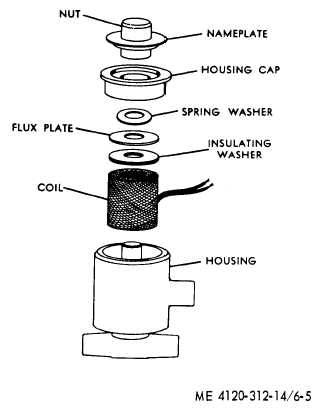|
| |
read between 1.45 and 2.2 amperes at no load. On
model CH-620-1 the ammeter should read be-
tween 1.75 and 2.5 amperes at no load. Start the
unit and check the ammeter reading. If the read-
ings are not equal, the motor bearings are worn
or the stator winding is defective. Follow the in-
structions in c following and disassemble the
motor for further testing.
b. Removal. Refer to paragraph 3-24 and re-
move the blower motor assembly.
c. Disassembly. Refer to figure 6-4 and disas-
semble the blower motor assembly as required.
d. Testing Procedure.
(1) Overload Protector. Disconnect the
electrical leads from the overload protector. Test
the protector with a multimeter set on the ohm
scale. If continuity does not exist, replace the ov-
erload protector.
(2) Motor Bench Test. Perform the growler
tests on the stator as instructed in TM 5-764. Re-
place defective stator.
e. Cleaning, Inspection and Repair.
(1) Clean all parts with a damp cloth and
dry thoroughly.
(2) Inspect the stator housing for cracks,
breaks, or defects.
(3) Inspect bearings for pits, scoring, wear,
or out-of-round condition.
(4) Inspect the rotor shaft for cracks, wear,
misalignment, gouges, pits, or other damage.
(5) Inspect the rotor for cracks, breaks, and
damaged laminations.
(6) Inspect all threaded parts for damage,
(7) Replace unserviceable parts with ser-
viceable like parts.
f. Reassembly. Reassemble the motor assembly
by reversing the order of disassembly,
g. Installation, Refer to paragraph 3-24 and
install the motor assembly.
6-4. Hot Gas Bypass Solenoid Valve
a. On-Equipment Testing.
(1) Remove the top cover (para 3-6).
(2) Start the air conditioner. In the bypass
mode of operation the tubing from the discharge
side of the valve should become warm immedi-
ately, If not, stop the unit and check the electri-
cal connection (para 5-12) and the solenoid coil.
If the valve fails to click upon the start of the by-
pass cycle, stop the unit and check the electrical
connection and coil. Refer to figure 5-4 and re-
move the electrical leads, Test the coil terminals
for continuity with a multimeter set on the ohm
scale, Continuity should exist between coil leads.
b. Removal. Remove the hot gas bypass sole-
noid valve (para 5-15).
c. Disassembly.
(1) Refer to figure 6-5 and disassemble the
hot gas bypass solenoid valve.
(2) Remove the tubing from the valve body.
Figure 6-5. Hot gas bypass solenoid valve,
disassembly and reassembly.
d. Repair. Replace unserviceable parts with
serviceable like parts.
e. Reassemble.
Caution: Heat must not be applied to as.
sembled valve.
(1) Solder the tubing to the valve body,
(2) Reassemble the hot gas bypass valve by
reversing the order of disassembly,
f. Installation. Install the hot gas bypass valve
(para 5-15).
6-5. Liquid line Bypass and Liquid Line
Solenoid Valves
a. On-Equipment Testing. Start the unit, If the
solenoid valve fails to click upon start of opera-
tion, stop the unit and check the valve coil and
connections in the same manner as used for the
hot gas bypass solenoid valve (para 6-4). The
liquid line solenoid valve is closed during the by-
pass cycle of operation, and is open during the
cooling cycle of operation. The liquid line bypass
6-6
|

